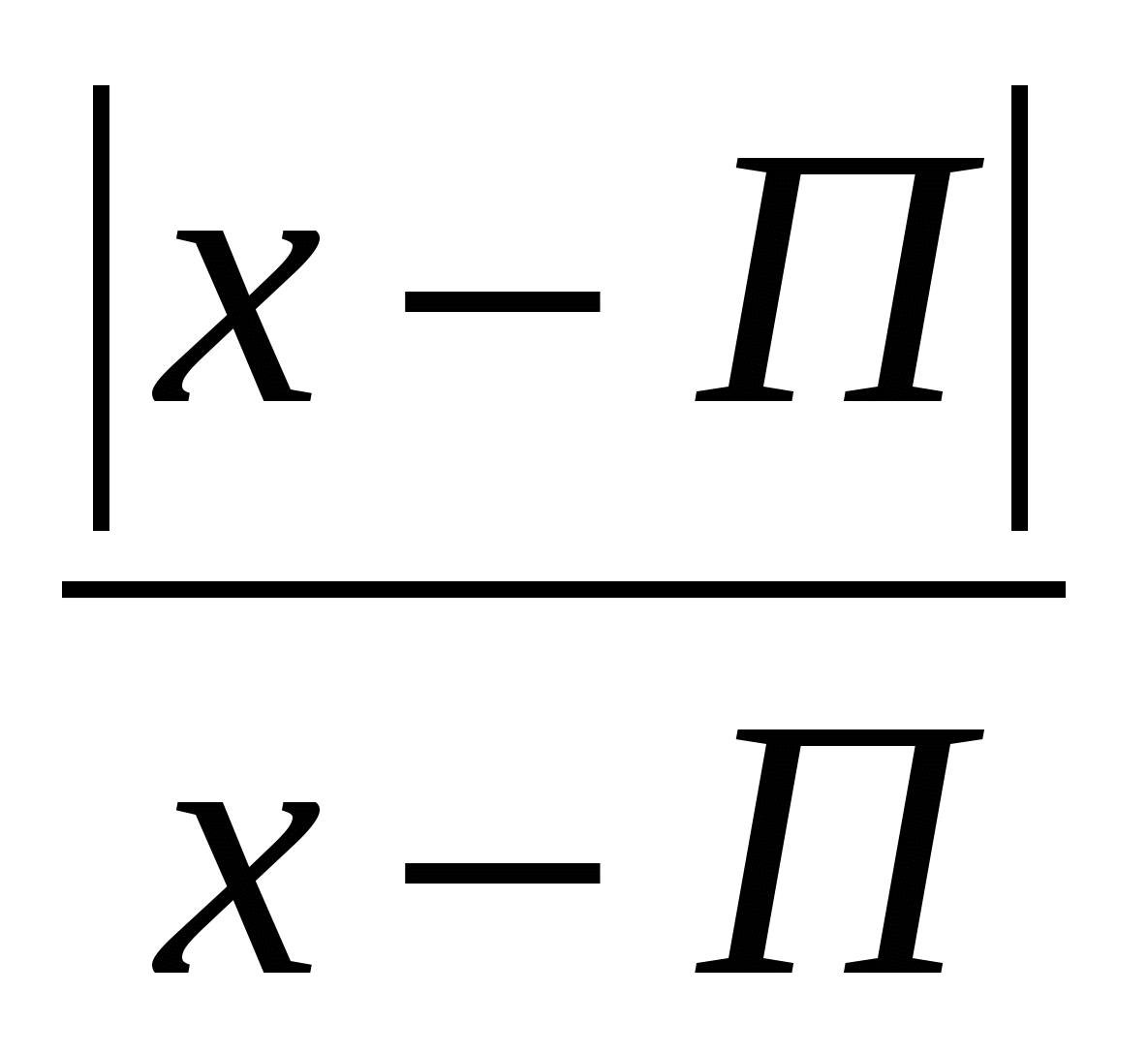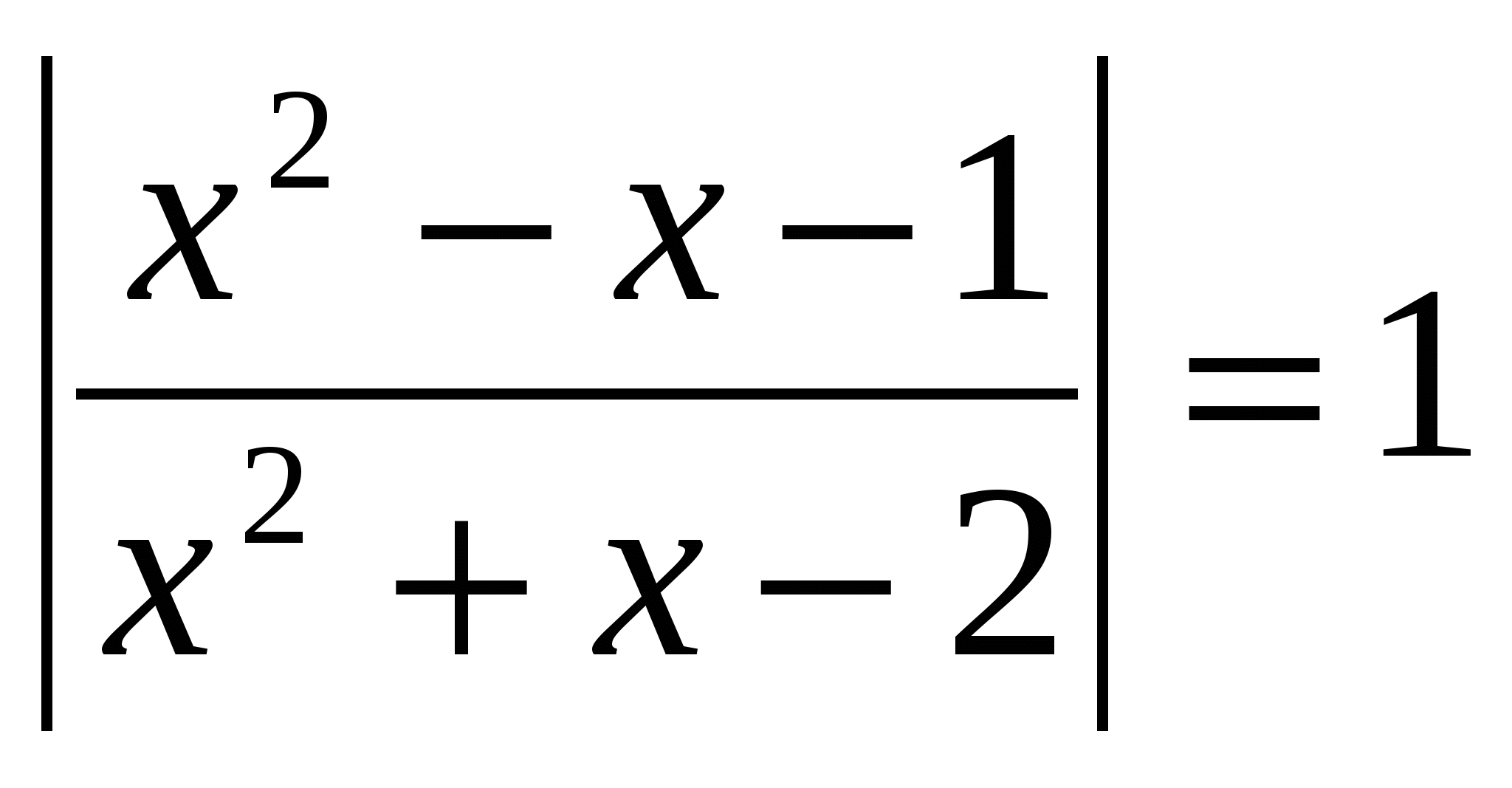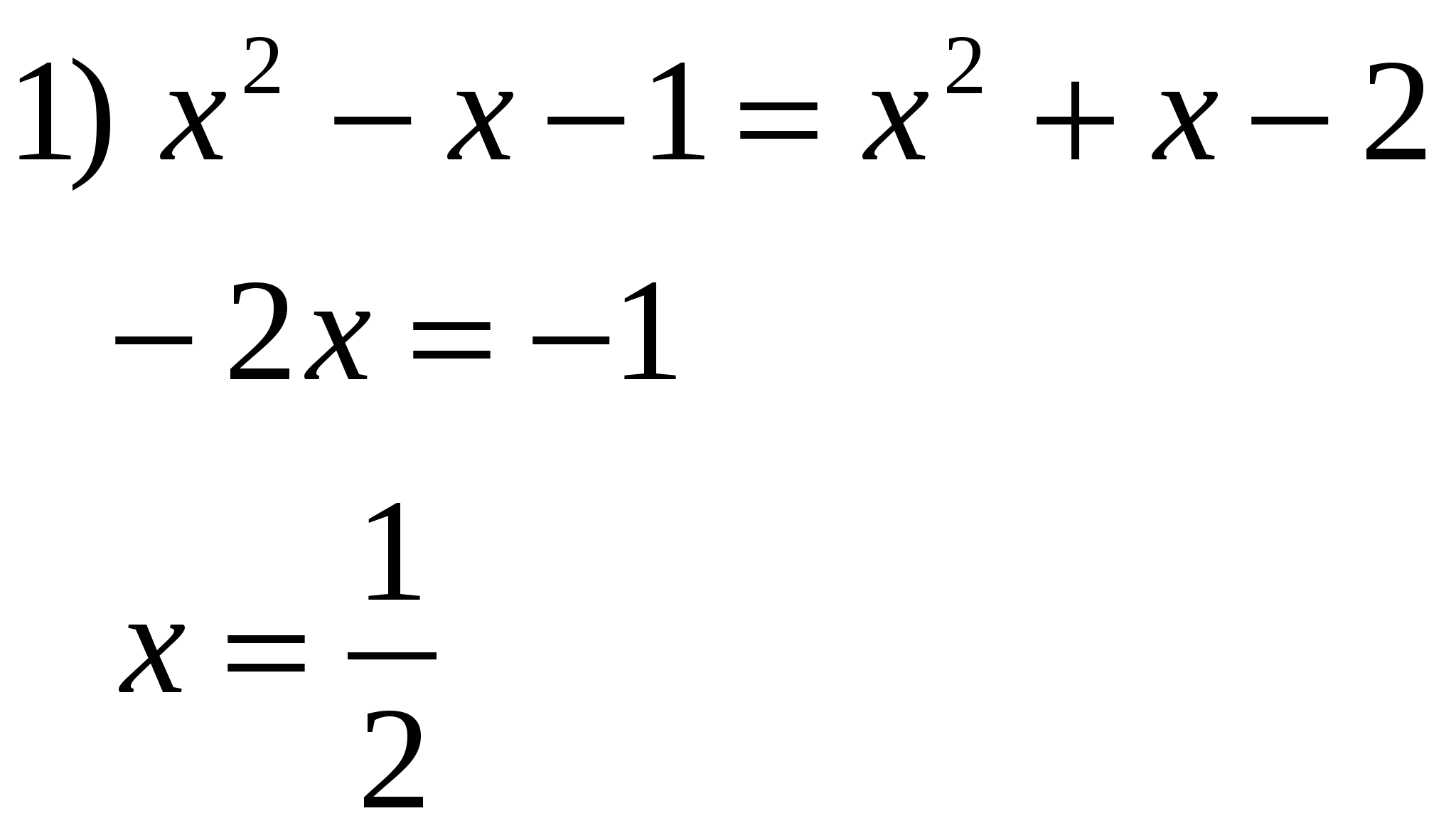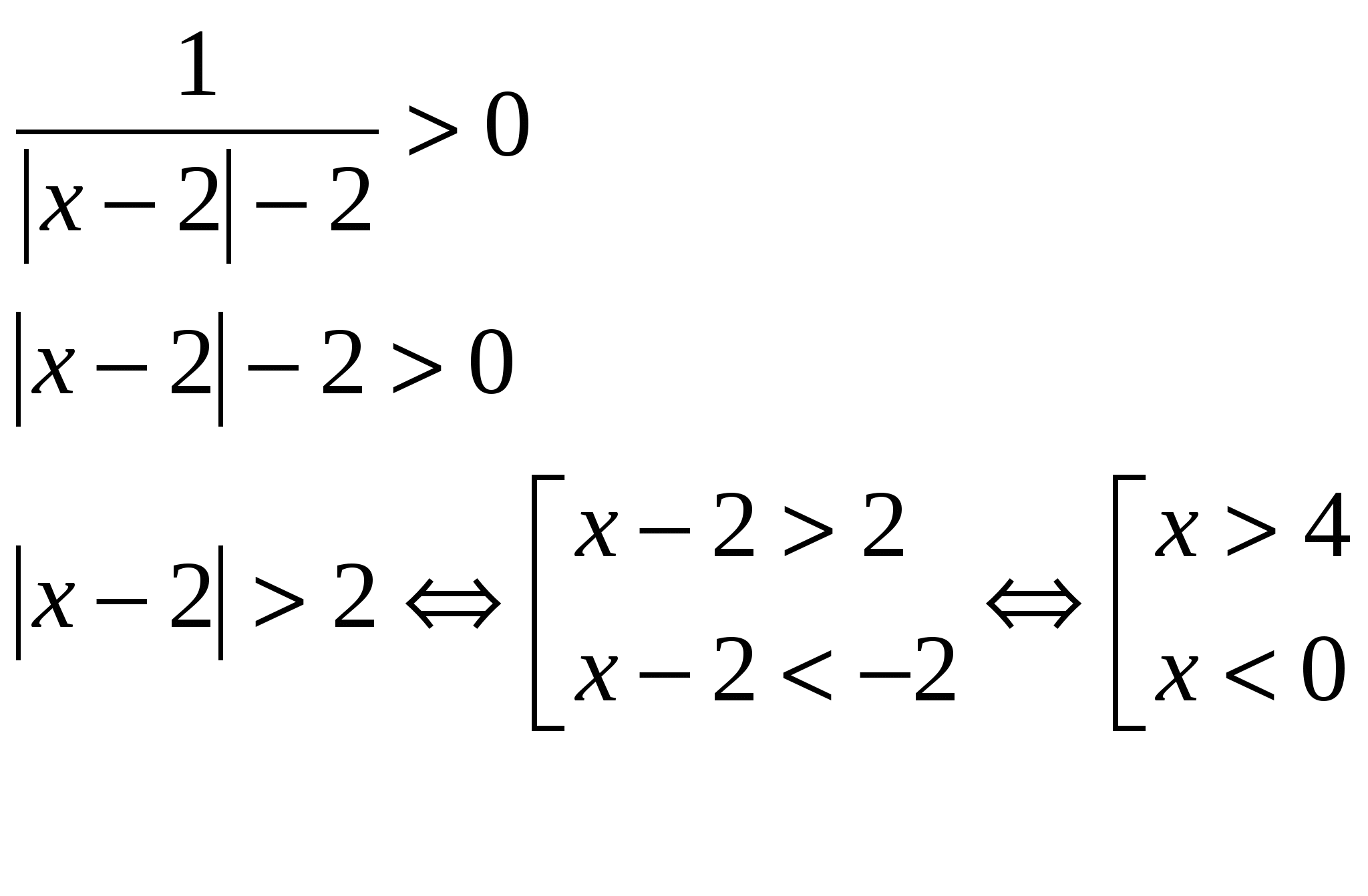Difference of modules equation. Methodical development "Equations with the module
The term (module) in literal translation from Latin means "measure". This concept was introduced into mathematics by the English scientist R. Cotes. And the German mathematician K. Weierstrass introduced the module sign - a symbol by which this concept is denoted when writing.
In contact with
For the first time this concept is studied in mathematics under the program of the 6th grade of high school. According to one definition, the modulus is the absolute value of a real number. In other words, to find out the modulus of a real number, you must discard its sign.
Graphically absolute value a denoted as |a|.
The main distinguishing feature of this concept is that it is always a non-negative value.
Numbers that differ from each other only in sign are called opposite numbers. If the value is positive, then its opposite is negative, and zero is its own opposite.
geometric value
If we consider the concept of the module from the standpoint of geometry, then it will denote the distance, which is measured in unit segments from the origin to given point. This definition fully reveals the geometric meaning of the term under study.

Graphically, this can be expressed as follows: |a| = O.A.
Absolute value properties
Below we will consider all the mathematical properties of this concept and ways of writing in the form of literal expressions:

Features of solving equations with a modulus
 If we talk about solving mathematical equations and inequalities that contain module, then you need to remember that in order to solve them, you will need to open this sign.
If we talk about solving mathematical equations and inequalities that contain module, then you need to remember that in order to solve them, you will need to open this sign.
For example, if the sign of the absolute value contains some mathematical expression, then before opening the module, it is necessary to take into account the current mathematical definitions.
|A + 5| = A + 5 if A is greater than or equal to zero.
5-A if A is less than zero.
In some cases, the sign can be unambiguously expanded for any value of the variable.
Let's consider one more example. Let's construct a coordinate line, on which we mark all numerical values, the absolute value of which will be 5.
First you need to draw a coordinate line, designate the origin of coordinates on it and set the size of a single segment. In addition, the line must have a direction. Now on this straight line it is necessary to apply markings that will be equal to the value of a single segment.
Thus, we can see that on this coordinate line there will be two points of interest to us with values 5 and -5.
MBOU secondary school №17 Ivanov
« Modulo Equations»
Methodical development
Compiled
math teacher
Lebedeva N.V.20010
Explanatory note
Chapter 1 Introduction
Section 2. Main features Section 3. Geometric interpretation of the concept of the modulus of a number Section 4. Graph of the function y = |x| Section 5 ConventionsChapter 2
Section 1. Equations of the form |F(х)| = m (protozoa) Section 2. Equations of the form F(|х|) = m Section 3. Equations of the form |F(х)| = G(x) Section 4. Equations of the form |F(х)| = ± F(x) (beautiful) Section 5. Equations of the form |F(х)| = |G(x)| Section 6. Examples of solving non-standard equations Section 7. Equations of the form |F(х)| + |G(x)| = 0 Section 8. Equations of the form |а 1 x ± в 1 | ± |a 2 x ± in 2 | ± …|a n x ± in n | = m Section 9. Equations Containing Multiple ModulesChapter 3. Examples of solving various equations with a modulus.
Section 1. Trigonometric equations Section 2 exponential equations Section 3. Logarithmic Equations Section 4. Irrational Equations Section 5. Tasks of advanced complexity Answers to the exercises BibliographyExplanatory note.
The concept of the absolute value (modulus) of a real number is one of its essential characteristics. This concept is widely used in various branches of physical, mathematical and technical sciences. In the practice of teaching a course of mathematics in high school in accordance with the Program of the Ministry of Defense of the Russian Federation, the concept of “absolute value of a number” occurs repeatedly: in the 6th grade, the definition of the module, its geometric meaning, is introduced; in the 8th grade, the concept of absolute error is formed, the solution of the simplest equations and inequalities containing the modulus is considered, the properties of the arithmetic square root are studied; in the 11th grade, the concept is found in the section “Root nth degree." Teaching experience shows that students often encounter difficulties in solving tasks that require knowledge of this material, and often skip before starting to complete. In the texts of examination tasks for the course of the 9th and 11th grades, similar tasks are also included. In addition, the requirements that universities impose on school graduates are different, namely, of a higher level than the requirements of the school curriculum. For life in modern society, the formation of a mathematical style of thinking, which manifests itself in certain mental skills, is very important. In the process of solving problems with modules, the ability to apply such techniques as generalization and concretization, analysis, classification and systematization, analogy is required. The solution of such tasks allows you to check the knowledge of the main sections of the school course, the level of logical thinking, and the initial skills of research. This work is devoted to one of the sections - the solution of equations containing the modulus. It consists of three chapters. The first chapter introduces the basic concepts and the most important theoretical calculations. The second chapter proposes nine basic types of equations containing the module, considers methods for solving them, and analyzes examples of different levels of complexity. The third chapter offers more complex and non-standard equations (trigonometric, exponential, logarithmic and irrational). For each type of equations there are exercises for independent solution (answers and instructions are attached). The main purpose of this work is to provide methodological assistance to teachers in preparing for lessons and in organizing optional courses. The material can also be used as study guide for high school students. The tasks proposed in the work are interesting and not always easy to solve, which makes it possible to make the learning motivation of students more conscious, test their abilities, and improve the level of preparation of school graduates for entering universities. A differentiated selection of the proposed exercises implies a transition from the reproductive level of assimilation of the material to the creative one, as well as the opportunity to teach how to apply their knowledge in solving non-standard problems.Chapter 1. Introduction.
Section 1. Determination of the absolute value .
Definition : The absolute value (modulus) of a real number a is called a non-negative number: a or -a. Designation: │ a │ The entry reads as follows: “module of the number a” or “absolute value of the number a”│ a if a > 0
│a│ = │ 0 if a = 0 (1)
│ - a, if aExamples: 1) │2,5│ = 2,5 2) │-7│ = 7 3) │1 - √2│ = √2 – 1
- Expand expression module:
Section 2. Basic properties.
Consider the basic properties of the absolute value. Property #1: Opposite numbers have equal modules, i.e. │а│=│-а│ Let us show the correctness of the equality. Let's write down the definition of the number - a : │- a│= (2) Let's compare sets (1) and (2). Obviously, the definitions of the absolute values of numbers a and - a match. Consequently, │а│=│-а│When considering the following properties, we confine ourselves to their formulation, since their proof is given in Property #2: The absolute value of the sum of a finite number real numbers does not exceed the sum of the absolute values of the terms: │a 1 + a 2 +…+ a n Property #3: The absolute value of the difference between two real numbers does not exceed the sum of their absolute values: │а - в│ ≤│а│+│в│ Property #4: The absolute value of the product of a finite number of real numbers is equal to the product of the absolute values of the factors: │а · в│=│а│·│в│ Property #5: The absolute value of the quotient of real numbers is equal to the quotient of their absolute values:

Section 3. Geometric interpretation of the concept of the modulus of a number.
Each real number can be associated with a point on the number line, which will be a geometric representation of this real number. Each point on the number line corresponds to its distance from the origin, i.e. the length of the segment from the origin to the given point. This distance is always considered as a non-negative value. Therefore, the length of the corresponding segment will be the geometric interpretation of the absolute value of the given real number
The presented geometric illustration clearly confirms property No. 1, i.e. moduli of opposite numbers are equal. From here, the validity of the equality is easily understood: │x - a│= │a - x│. It also becomes more obvious to solve the equation │х│= m, where m ≥ 0, namely x 1.2 = ± m. Examples: 1) │х│= 4 x 1.2 = ± 4 2) │х - 3│= 1
 x 1.2 = 2; four
x 1.2 = 2; four Section 4. Graph of the function y \u003d │х│
The domain of this function is all real numbers.Section 5. Symbols.
In the future, when considering examples of solving equations, the following conventions will be used: ( - system sign [ - set sign When solving a system of equations (inequalities), the intersection of the solutions of the equations (inequalities) included in the system is found. When solving a set of equations (inequalities), a union of solutions of the equations (inequalities) included in the set is found.Chapter 2
In this chapter, we will look at algebraic ways to solve equations containing one or more modules.Section 1. Equations of the form │F (х) │= m
An equation of this type is called the simplest. It has a solution if and only if m ≥ 0. By the definition of the modulus, the original equation is equivalent to the combination of two equations: │ F(x)│=m
 Examples:
Examples:
№1. Solve the equation: │7x - 2│= 9


 Answer: x 1
= - 1; X 2
= 1
4
/
7
№2
Answer: x 1
= - 1; X 2
= 1
4
/
7
№2
│x 2 + 3x + 1│= 1

 x 2 + 3x + 2 = 0 x 2 + 3x = 0 x 1 = -1; x 2 \u003d -2 x (x + 3) \u003d 0 x 1 \u003d 0; x 2 = -3 Answer: the sum of the roots is - 2.№3
x 2 + 3x + 2 = 0 x 2 + 3x = 0 x 1 = -1; x 2 \u003d -2 x (x + 3) \u003d 0 x 1 \u003d 0; x 2 = -3 Answer: the sum of the roots is - 2.№3
│x 4 -5x 2 + 2│= 2 x 4 - 5x 2 = 0 x 4 - 5x 2 + 4 = 0 x 2 (x 2 - 5) = 0 denote x 2 = m, m ≥ 0 x = 0 ; ±√5 m 2 – 5m + 4 = 0 m = 1; 4 – both values satisfy the condition m ≥ 0 x 2 = 1 x 2 = 4 x = ± 1 x = ± 2 Answer: the number of roots of equation 7. Exercises:
№1. Solve the equation and indicate the sum of the roots: │x - 5│= 3 №2 . Solve the equation and indicate the smaller root: │x 2 + x │ \u003d 0 №3 . Solve the equation and indicate the larger root: │x 2 - 5x + 4 │ \u003d 4 №4 .Solve the equation and indicate the whole root: │2x 2 - 7x + 6│ \u003d 1 №5 .Solve the equation and indicate the number of roots: │x 4 - 13x 2 + 50 │ = 14
Section 2. Equations of the form F(│х│) = m
The function argument on the left side is under the modulo sign, while the right side is independent of the variable. Let us consider two ways of solving equations of this type. 1 way: By definition of the absolute value, the original equation is equivalent to the totality of two systems. In each of which a condition is imposed on the submodule expression. F(│х│) =m Since the function F(│х│) is even on the entire domain of definition, the roots of the equations F(х) = m and F(-х) = m are pairs of opposite numbers. Therefore, it suffices to solve one of the systems (when considering examples in this way, the solution of one system will be given). 2 way: Application of the method of introducing a new variable. In this case, the designation │х│= a is introduced, where a ≥ 0. This method less voluminous in design.
Since the function F(│х│) is even on the entire domain of definition, the roots of the equations F(х) = m and F(-х) = m are pairs of opposite numbers. Therefore, it suffices to solve one of the systems (when considering examples in this way, the solution of one system will be given). 2 way: Application of the method of introducing a new variable. In this case, the designation │х│= a is introduced, where a ≥ 0. This method less voluminous in design. Examples: №1 . Solve the equation: 3x 2 - 4│x│ = - 1 Let's use the introduction of a new variable. Denote │х│= a, where a ≥ 0. We get the equation 3a 2 - 4a + 1 = 0 D = 16 - 12 = 4 a 1 = 1 a 2 = 1 / 3 We return to the original variable: │х│ = 1 and │х│= 1/3. Each equation has two roots. Answer: x 1 = 1; X 2 = - 1; X 3 = 1 / 3 ; X 4 = - 1 / 3 . №2. Solve the equation: 5x 2 + 3│x│- 1 \u003d 1 / 2 │x│ + 3x 2
 Let's find the solution of the first set system: 4x 2 + 5x - 2 \u003d 0 D \u003d 57 x 1 \u003d -5 + √57 / 8 x 2 \u003d -5-√57 / 8 Note that x 2 does not satisfy the condition x ≥ 0. By the solution the second system will be the opposite number x 1 . Answer: x 1
=
-5+√57
/
8
; X 2
=
5-√57
/
8
.№3
.
Solve the equation: x 4 - │х│= 0 Denote │х│= a, where a ≥ 0. We get the equation a 4 - a \u003d 0 a (a 3 - 1) \u003d 0 a 1 \u003d 0 a 2 \u003d 1 We return to the original variable: │х│=0 and │х│= 1 x = 0; ± 1 Answer: x 1
= 0; X 2
= 1; X 3
= - 1.
Let's find the solution of the first set system: 4x 2 + 5x - 2 \u003d 0 D \u003d 57 x 1 \u003d -5 + √57 / 8 x 2 \u003d -5-√57 / 8 Note that x 2 does not satisfy the condition x ≥ 0. By the solution the second system will be the opposite number x 1 . Answer: x 1
=
-5+√57
/
8
; X 2
=
5-√57
/
8
.№3
.
Solve the equation: x 4 - │х│= 0 Denote │х│= a, where a ≥ 0. We get the equation a 4 - a \u003d 0 a (a 3 - 1) \u003d 0 a 1 \u003d 0 a 2 \u003d 1 We return to the original variable: │х│=0 and │х│= 1 x = 0; ± 1 Answer: x 1
= 0; X 2
= 1; X 3
= - 1.
Exercises: №6. Solve the equation: 2│х│ - 4.5 = 5 - 3/8 │х│ №7 . Solve the equation, in the answer indicate the number of roots: 3x 2 - 7│x│ + 2 = 0 №8 . Solve the equation, in the answer indicate the whole solutions: x 4 + │х│ - 2 = 0
Section 3. Equations of the form │F(х)│ = G(х)
The right side of an equation of this type depends on a variable and, therefore, has a solution if and only if the right side is a function G(x) ≥ 0. The original equation can be solved in two ways: 1 way: Standard, based on the disclosure of the module based on its definition and consists in an equivalent transition to the combination of two systems. │ F(x)│ =G(X)
 It is rational to use this method in the case of a complex expression for the function G(x) and a less complex expression for the function F(x), since it is supposed to solve inequalities with the function F(x). 2 way: It consists in the transition to an equivalent system in which a condition is imposed on the right side. │ F(x)│=
G(x)
It is rational to use this method in the case of a complex expression for the function G(x) and a less complex expression for the function F(x), since it is supposed to solve inequalities with the function F(x). 2 way: It consists in the transition to an equivalent system in which a condition is imposed on the right side. │ F(x)│=
G(x)

 This method is more convenient to use if the expression for the function G(x) is less complicated than for the function F(x), since the solution of the inequality G(x) ≥ 0 is assumed. In addition, in the case of several modules, this method is recommended to use the second option. Examples:
№1.
Solve the equation: │x + 2│= 6 -2x
This method is more convenient to use if the expression for the function G(x) is less complicated than for the function F(x), since the solution of the inequality G(x) ≥ 0 is assumed. In addition, in the case of several modules, this method is recommended to use the second option. Examples:
№1.
Solve the equation: │x + 2│= 6 -2x  (1 way) Answer: x = 1 1
/
3
№2.
(1 way) Answer: x = 1 1
/
3
№2.
│x 2 - 2x - 1 │ \u003d 2 (x + 1)
 (2 way) Answer: The product of the roots is 3.
(2 way) Answer: The product of the roots is 3.№3. Solve the equation, in the answer write the sum of the roots:
│x - 6 │ \u003d x 2 - 5x + 9

Answer: the sum of the roots is 4.
Exercises: №9. │x + 4│= - 3x №10. Solve the equation, in the answer indicate the number of solutions: │x 2 + x - 1 │ \u003d 2x - 1 №11 . Solve the equation, in the answer indicate the product of the roots: │x + 3 │ \u003d x 2 + x - 6
Section 4. Equations of the form │F(x)│= F(x) and │F(x)│= - F(x)
Equations of this type are sometimes called "beautiful". Since the right side of the equations depends on the variable, solutions exist if and only if the right side is non-negative. Therefore, the original equations are equivalent to the inequalities:│F(x)│= F(x) F(x) ≥ 0 and │F(x)│= - F(x) F(x) Examples: №1 . Solve the equation, in the answer indicate the smaller integer root: │5x - 3│ \u003d 5x - 3 5x - 3 ≥ 0 5x ≥ 3 x ≥ 0.6 Answer: x = 1№2. Solve the equation, in the answer indicate the length of the gap: │x 2 - 9 │ \u003d 9 - x 2 x 2 - 9 ≤ 0 (x - 3) (x + 3) ≤ 0 [- 3; 3] Answer: the length of the gap is 6.№3 . Solve the equation, in the answer indicate the number of integer solutions: │2 + x - x 2 │ = 2 + x - x 2 2 + x - x 2 ≥ 0 x 2 - x - 2 ≤ 0 [- 1; 2] Answer: 4 whole solutions.№4 . Solve the equation, in the answer indicate the largest root:
│4 - x -
 │= 4 – x –
│= 4 – x –  x 2 - 5x + 5 \u003d 0 D \u003d 5 x 1.2 \u003d
x 2 - 5x + 5 \u003d 0 D \u003d 5 x 1.2 \u003d  ≈ 1,4
≈ 1,4Answer: x = 3.
Exercises:
№12.
Solve the equation, in the answer indicate the whole root: │x 2 + 6x + 8 │= x 2 + 6x + 8 №13.
Solve the equation, in the answer indicate the number of integer solutions: │13x - x 2 - 36│+ x 2 - 13x + 36 = 0 №14.
Solve the equation, in the answer indicate an integer that is not the root of the equation: 
Section 5. Equations of the form │F(x)│= │G(x)│
Since both sides of the equation are non-negative, the solution involves considering two cases: submodule expressions are equal or opposite in sign. Therefore, the original equation is equivalent to the combination of two equations: │ F(x)│= │ G(x)│ Examples:
№1.
Solve the equation, in the answer indicate the whole root: │x + 3│ \u003d │2x - 1│
Examples:
№1.
Solve the equation, in the answer indicate the whole root: │x + 3│ \u003d │2x - 1│  Answer: integer root x = 4.№2.
Solve the equation: │
x - x 2 - 1│ \u003d │2x - 3 - x 2 │
Answer: integer root x = 4.№2.
Solve the equation: │
x - x 2 - 1│ \u003d │2x - 3 - x 2 │  Answer: x = 2.№3
.
Solve the equation, in the answer indicate the product of the roots:
Answer: x = 2.№3
.
Solve the equation, in the answer indicate the product of the roots: 


 The roots of the equation 4x 2 + 2x - 1 \u003d 0 x 1.2 \u003d - 1±√5 / 4 Answer: the product of the roots is 0.25. Exercises:
№15
. Solve the equation, in the answer indicate the whole solution: │x 2 - 3x + 2│ \u003d │x 2 + 6x - 1│ №16.
Solve the equation, in the answer indicate the smaller root: │5x - 3│=│7 - x│ №17
. Solve the equation, in the answer write the sum of the roots:
The roots of the equation 4x 2 + 2x - 1 \u003d 0 x 1.2 \u003d - 1±√5 / 4 Answer: the product of the roots is 0.25. Exercises:
№15
. Solve the equation, in the answer indicate the whole solution: │x 2 - 3x + 2│ \u003d │x 2 + 6x - 1│ №16.
Solve the equation, in the answer indicate the smaller root: │5x - 3│=│7 - x│ №17
. Solve the equation, in the answer write the sum of the roots: 
Section 6. Examples of solving non-standard equations
In this section, we consider examples of non-standard equations, in the solution of which the absolute value of the expression is revealed by definition. Examples:№1.
Solve the equation, in the answer indicate the sum of the roots: x │x│- 5x - 6 \u003d 0  Answer: the sum of the roots is 1 №2.
.
Solve the equation, in the answer indicate the smaller root: x 2 - 4x
Answer: the sum of the roots is 1 №2.
.
Solve the equation, in the answer indicate the smaller root: x 2 - 4x  - 5 = 0
- 5 = 0  Answer: smaller root x = - 5. №3.
Solve the equation:
Answer: smaller root x = - 5. №3.
Solve the equation:  Answer: x = -1. Exercises:
№18.
Solve the equation and write the sum of the roots: x │3x + 5│= 3x 2 + 4x + 3
Answer: x = -1. Exercises:
№18.
Solve the equation and write the sum of the roots: x │3x + 5│= 3x 2 + 4x + 3
№19.
Solve the equation: x 2 - 3x \u003d 
№20.
Solve the equation: 
Section 7. Equations of the form │F(x)│+│G(x)│=0
It is easy to see that on the left side of an equation of this type, the sum of non-negative quantities. Therefore, the original equation has a solution if and only if both terms are simultaneously equal to zero. The equation is equivalent to the system of equations: │ F(x)│+│ G(x)│=0 Examples:
№1
. Solve the equation:
Examples:
№1
. Solve the equation:  Answer: x = 2. №2.
Solve the equation: Answer: x = 1. Exercises:
№21.
Solve the equation: №22
. Solve the equation, in the answer write the sum of the roots: №23
. Solve the equation, in the answer indicate the number of solutions:
Answer: x = 2. №2.
Solve the equation: Answer: x = 1. Exercises:
№21.
Solve the equation: №22
. Solve the equation, in the answer write the sum of the roots: №23
. Solve the equation, in the answer indicate the number of solutions: Section 8. Equations of the form
To solve equations of this type, the method of intervals is used. If it is solved by sequential expansion of modules, then we get n sets of systems, which is very cumbersome and inconvenient. Consider the algorithm of the interval method: 1). Find Variable Values X, for which each module is equal to zero (zeros of submodule expressions): 2). The found values are marked on a number line, which is divided into intervals (the number of intervals, respectively, is equal to n+1
) 3). Determine with what sign each module is revealed at each of the obtained intervals (when making a solution, you can use a number line, marking the signs on it) 4). The original equation is equivalent to the set n+1
systems, in each of which the membership of the variable is indicated X one of the intervals. Examples:
№1
. Solve the equation, in the answer indicate the largest root:
2). The found values are marked on a number line, which is divided into intervals (the number of intervals, respectively, is equal to n+1
) 3). Determine with what sign each module is revealed at each of the obtained intervals (when making a solution, you can use a number line, marking the signs on it) 4). The original equation is equivalent to the set n+1
systems, in each of which the membership of the variable is indicated X one of the intervals. Examples:
№1
. Solve the equation, in the answer indicate the largest root:  one). Let's find the zeros of submodule expressions: x = 2; x = -3 2). We mark the found values on the number line and determine with what sign each module is revealed on the obtained intervals:
one). Let's find the zeros of submodule expressions: x = 2; x = -3 2). We mark the found values on the number line and determine with what sign each module is revealed on the obtained intervals: x – 2 x – 2 x – 2 - - + - 3 2 x 2x + 6 2x + 6 2x + 6 - + + 3)
 - no solutions The equation has two roots. Answer: the largest root is x = 2. №2.
Solve the equation, write the whole root in the answer:
- no solutions The equation has two roots. Answer: the largest root is x = 2. №2.
Solve the equation, write the whole root in the answer:  one). Let's find the zeros of submodule expressions: x = 1.5; x = - 1 2). We mark the found values on the number line and determine with what sign each module is revealed on the obtained intervals: x + 1 x + 1 x + 1 - + +
one). Let's find the zeros of submodule expressions: x = 1.5; x = - 1 2). We mark the found values on the number line and determine with what sign each module is revealed on the obtained intervals: x + 1 x + 1 x + 1 - + + -1 1.5 х 2х – 3 2х – 3 2х – 3 - - +
3).
 The last system has no solutions, therefore, the equation has two roots. When solving the equation, you should pay attention to the “-” sign in front of the second module. Answer: integer root x = 7. №3.
Solve the equation, in the answer indicate the sum of the roots: 1). Let's find the zeros of submodule expressions: x = 5; x = 1; x = - 2 2). We mark the found values on the number line and determine with what sign each module is revealed on the obtained intervals: x - 5 x - 5 x - 5 x - 5 - - - +
The last system has no solutions, therefore, the equation has two roots. When solving the equation, you should pay attention to the “-” sign in front of the second module. Answer: integer root x = 7. №3.
Solve the equation, in the answer indicate the sum of the roots: 1). Let's find the zeros of submodule expressions: x = 5; x = 1; x = - 2 2). We mark the found values on the number line and determine with what sign each module is revealed on the obtained intervals: x - 5 x - 5 x - 5 x - 5 - - - + -2 1 5 x x – 1 x – 1 x – 1 x – 1 - - + + x + 2 x + 2 x + 2 x + 2 - + + +
3).
 The equation has two roots x = 0 and 2. Answer: the sum of the roots is 2. №4
.
Solve the equation: 1). Let's find the zeros of submodule expressions: x = 1; x = 2; x = 3. 2). Let us determine the sign with which each module is expanded on the obtained intervals. 3).
The equation has two roots x = 0 and 2. Answer: the sum of the roots is 2. №4
.
Solve the equation: 1). Let's find the zeros of submodule expressions: x = 1; x = 2; x = 3. 2). Let us determine the sign with which each module is expanded on the obtained intervals. 3).  Let's combine the solutions of the first three systems. Answer: ; x = 5.
Let's combine the solutions of the first three systems. Answer: ; x = 5.Exercises: №24. Solve the equation:
 №25.
Solve the equation, in the answer write the sum of the roots: №26.
Solve the equation, in the answer indicate the smaller root: №27.
Solve the equation, give the larger root in your answer:
№25.
Solve the equation, in the answer write the sum of the roots: №26.
Solve the equation, in the answer indicate the smaller root: №27.
Solve the equation, give the larger root in your answer: Section 9. Equations Containing Multiple Modules
Equations containing multiple modules assume the presence of absolute values in submodule expressions. The basic principle of solving equations of this type is the sequential disclosure of modules, starting with the "external". In the course of the solution, the techniques discussed in sections No. 1, No. 3 are used.Examples:
№1.
Solve the equation:  Answer: x = 1; - eleven. №2.
Solve the equation:
Answer: x = 1; - eleven. №2.
Solve the equation:
Answer: x = 0; four; - four. №3.
Solve the equation, in the answer indicate the product of the roots:  Answer: The product of the roots is 8. №4.
Solve the equation:
Answer: The product of the roots is 8. №4.
Solve the equation:  Denote the population equations (1)
and (2)
and consider the solution of each of them separately for the convenience of design. Since both equations contain more than one module, it is more convenient to carry out an equivalent transition to sets of systems. (1)
Denote the population equations (1)
and (2)
and consider the solution of each of them separately for the convenience of design. Since both equations contain more than one module, it is more convenient to carry out an equivalent transition to sets of systems. (1)

 (2)
(2)


 Answer:
Answer:
Exercises:
№36.
Solve the equation, in the answer indicate the sum of the roots: 5 │3x-5│ \u003d 25 x №37.
Solve the equation, if there are more than one roots, in the answer indicate the sum of the roots: │x + 2│ x - 3x - 10 = 1 №38.
Solve the equation: 3 │2x -4│ \u003d 9 │x│ №39.
Solve the equation, in the answer indicate the number of roots for: 2 │ sin x │ = √2 №40
. Solve the equation, in the answer indicate the number of roots:
Section 3. Logarithmic equations.
Before solving the following equations, it is necessary to review the properties of logarithms and the logarithmic function. Examples: №1. Solve the equation, in the answer indicate the product of the roots: log 2 (x + 1) 2 + log 2 │x + 1 │ \u003d 6 O.D.Z. x+1≠0 x≠ - 1Case 1: if x ≥ - 1, then log 2 (x+1) 2 + log 2 (x+1) = 6 log 2 (x+1) 3 = log 2 2 6 (x+1) 3 = 2 6 x+1 = 4 x = 3 – satisfies the condition x ≥ - 1 2 case: if x log 2 (x+1) 2 + log 2 (-x-1) = 6 log 2 (x+1) 2 + log 2 (-(x+1)) = 6 log 2 (-(x+1) 3) = log 2 2 6- (x+1) 3 = 2 6- (x+1) = 4 x = - 5 – satisfies condition x - 1
Answer: The product of the roots is 15.
№2.
Solve the equation, in the answer indicate the sum of the roots: lg  O.D.Z.
O.D.Z. 



Answer: the sum of the roots is 0.5.
№3.
Solve the equation: log 5  O.D.Z.
O.D.Z. 
 Answer: x = 9. №4.
Solve the equation: │2 + log 0.2 x│+ 3 = │1 + log 5 x│ O.D.Z. x > 0 Let's use the formula for moving to another base. │2 - log 5 x│+ 3 = │1 + log 5 x│
Answer: x = 9. №4.
Solve the equation: │2 + log 0.2 x│+ 3 = │1 + log 5 x│ O.D.Z. x > 0 Let's use the formula for moving to another base. │2 - log 5 x│+ 3 = │1 + log 5 x│
│2 - log 5 x│- │1 + log 5 x│= - 3 Let's find the zeros of submodule expressions: x = 25; x \u003d These numbers divide the area of \u200b\u200bpermissible values into three intervals, so the equation is equivalent to the totality of three systems.  Answer: )
Answer: )



